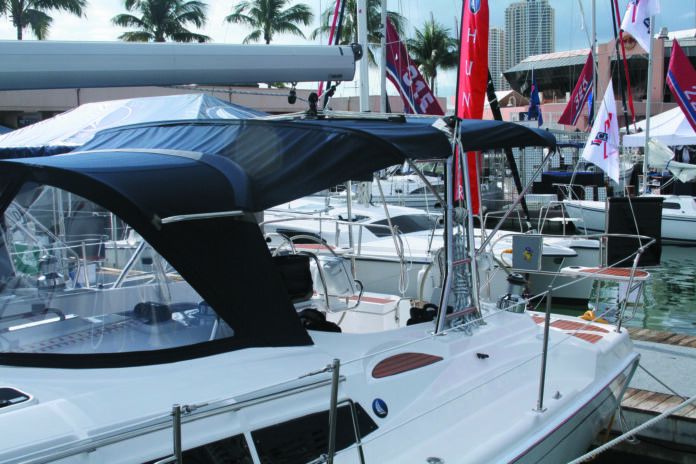So you want to build the awning described on page 7 of this issue, and were wondering what material to use. We’ve been using a polypropylene tarp that will add plastic to the landfill, so we too are curious. Sail cloth will set best, but it also will eventually be weakened by the sun, is less effective at blocking sun, and is bulky to fold. Sunbrella will last the longest, but it stretches and is bulky. Coated nylon is waterproof and compact, but in our experience it won’t hold up in the sun and it will stretch too much. So many choices. We’ll settle this eventually, but for now we’re going to focus on color and which are coolest.
We cut squares of new and old Sunbrella in several colors and one square of white polyester sail cloth. We staked them out in the sun and measured the temperature of the cloth and the air under it. We also tested transmission using visible light; UV transmission is slightly lower and infrared considerably higher, but overall, energy transfer is 1.5 to 3 times greater than visible light measurements.
OBSERVATIONS
We calculated the heat gain under the awning both by considering the difference between transmission and reflectance values (the difference is cloth heating) and by measuring the cloth temperature and applying engineering calculations for re-radiation and convection. The differences were small and consistent. Dark colors got quiet warm in the mid-summer sun (mid-day, mid-June, at 38 degrees North), as much as 55F above ambient temperature, where as light colors were only 5-10 degrees warmer.
Dark colors block the sun more effectively than lighter colors; 0-7% transmission vs. 18-25% for the lightest colors. They also last twice as long in the sun; 7-12 years vs. 4-7 years. Light colors reflect more light and heat away from the cockpit. Transmission will typically double over the life of the awning as the cloth weathers, regardless of the color; differences are so great that this change does not impact the results or the rank ordering. The difference in UV protection is less important, because all colors block >90%, and there are also contributions from reflected light and other sailing exposures. The bottom line is that the differences between Sunbrella colors were less than we expected, and if the awning is positioned high (which will help heat from the surface of the cloth to ventilate), the temperature difference will shrink—especially as the wind begins to blow.
We have also painted dark awnings on two different boats and observed first hand the difference the combination of high opacity (low transmission) and high reflectance can make; the temperature can be 5-10F cooler under a painted awning. Testing confirmed this. The down side is a painted awning, even when made of light cloth, is stiff and hard to store. A flexible aluminized (high reflectivity and high opacity) paint over a light sail cloth might be the answer for an awning, but we haven’t found the coating.
CONCLUSIONS
For most canvas work, such as dodgers, sheet bags, and window covers, we recommend darker colors because they last longer and hide dirt better. But for awnings and biminis the difference in heating swings the needle towards offwhite shades. We’re still looking for that miracle fabric that is low stretch, durable in the sun, flexible, reflective, and opaque.





































Have you tried ” Silvicool Tarps ” ? They are white with a silver lining. They are quite heavy duty. They are used on the silviculture and tree planting here in western Canada. I have used them, but have not done any comparisons with them . The larger one’s joints are not sealed , so they are not water tight at the joints . After a number of years the silver lining came off , but that may be because I set them with the silver side up .
The post consumer waste plastic tarps generate does bother me . I use a bamboo curtain for a bimini. It works great , keeps cool on the hottest day , not much more then ambient temperature. But they are heavy and awkward . Not easy to use for shade cloth over the boat when moored or anchored . Have you done any test using natural fibres ? How well does natural sailcloth stand up in comparison to synthetic?
Thanks for the work all .